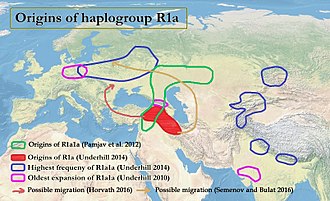These people mixed with the local populations and are found (as I said) from Ireland to Western China.
"R1a1a (R-M17 or R-M198) is the sub-clade most commonly associated with Indo-European speakers. Most discussions purportedly of R1a origins are actually about the origins of the dominant R1a1a (R-M17 or R-M198) sub-clade. Data so far collected indicates that there are two widely separated areas of high frequency, one in South Asia, around North India, and the other in Eastern Europe, around Poland and Ukraine."
(citation needed) https://en.wikipedia.org/wiki/Indo-Iranians#Genetics
https://en.wikipedia.org/wiki/Haplogroup_R1a, particularly
https://en.wikipedia.org/wiki/Haplogroup_R1a#Geographic_distribution_of_R1a1a
Archaeological cultures associated with Indo-Iranian expansion include:
Europe: Poltavka culture (2700–2100 BC)
Central Asia: Andronovo horizon (2200–1000 BC), Sintashta-Petrovka-Arkaim (2200–1600 BC), Alakul (2100–1400 BC), Fedorovo (1400–1200 BC), Alekseyevka (1200–1000 BC), Bactria-Margiana Archaeological Complex (2200–1700 BC), Srubna culture (2000–1100 BC), Abashevo culture (1700–1500 BC), Yaz culture (1500–1100 BC)
India (middle Ganges plains): Painted Gray Ware culture (1100–350 BC)
Iran: Early West Iranian Grey Ware (1500–1000 BC), Late West Iranian Buff Ware (900–700 BC)
Indo-Pak sub-continent: Swat culture (1600–500 BC), Cemetery H culture (1900–1300 BC)
https://en.wikipedia.org/wiki/Indo-Iranians#Archaeology
https://en.wikipedia.org/wiki/Indo-European_migrations



